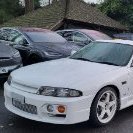Rear Tyres Wearing Out Need Camber Kit?
Announcements
-
Similar Content
-
Latest Posts
-
By AnimalGarage · Posted
It would be different if the sealant hadn't started to peel up with gaps in the glue about ~6cm and bigger in some areas. I would much prefer not having to do the work take them off the car . However, the filler the owner put in the roof rack mount cavities has shrunk and begun to crack on the rail delete panels. I cant trust that to hold off moisture ingress especially where I live. Not only that but I have faded paint on as well as on either side of these panels, so they would need to come off to give the roofline a proper respray. My goal is to get in there and put a healthy amount of epoxy instead of panel filler/bog and potentially skin with carbon fiber. I have 2 spare rolls from an old motorcycle fairing project from a few years back and I think it'd be a nice touch on a black stag. I've seen some threads where people replace their roof rack delete with a welded in sheet metal part. But has anyone re-worked the roof rails themselves? It seems like there is a lot of volume there to add in some threads and maybe a keyway for a quick(er) release roof rack system. Not afraid to mill something out if I have to. It would be cool to have a cross bar only setup. That way I can keep the sleek roofline that would accept a couple bolts to gain back that extra utility 3D print some snazzy covers to hide the threaded section to be thorough and keep things covered when not using the rack. -
Probably not. A workshop grade scantool is my go to for proper Consult interrogation. Any workshop grade tool should do it. Just go to a workshop.
-
By GabsReDeal · Posted
In my head it does make sense to be a fuel problem since that is what I touched when cleaning the system. When I was testing with the fuel pressure gauge, the pressure was constantly 2.5 bar with the FPR vacuum removed. When stalling, the pressure was going up to 3.0 bar (which is how it should be on ignition). -
ECUtalk pages don't mention they support the ABS computer (consult port has more than one CAN), so you might just need a different scan tool. But, I would expect ABS is a different light to the brake warning/handbrake light, do you see an ABS light come on for a few seconds when you turn the key from ACC to IGN? But since you said: I'd have a look at the ABS sensors in the rear hubs to make sure they are not damaged, disconnected etc.
-
OK, if it idles at 1000+ with the AAC, its not an idle airflow problem. The cold start valve just gives extra air when the engine is cold, but you have enough air without it to idle at 1000. I think you are back to a fuel problem, sorry. Can you see the fuel pressure staying constant or does it drop as the revs drop to a stall?
-





Recommended Posts
Create an account or sign in to comment
You need to be a member in order to leave a comment
Create an account
Sign up for a new account in our community. It's easy!
Register a new accountSign in
Already have an account? Sign in here.
Sign In Now